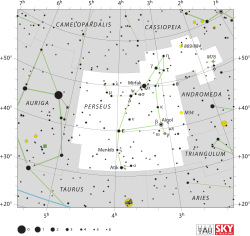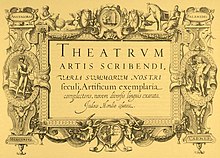카파 페르세이
Kappa Persei| 관측 데이터 Epoch J2000.0 이쿼녹스 J2000.0(ICRS) | |
|---|---|
| 별자리 | 페르세우스 |
| 우측 상승 | 03h 09m 29.77156s[1] |
| 탈위임 | +44° 51′ 27.1463″[1] |
| 겉보기 크기 (V) | 3.80[2] |
| 특성. | |
| 스펙트럼형 | G9.5 IIIb[3] |
| U-B색지수 | +0.83[2] |
| B-V색지수 | +0.98[2] |
| 아스트로메트리 | |
| 방사 속도 (Rv) | 27.43±0.42km[4]/s |
| 고유 운동 (μ) | RA: +1909.99mas[1]/yr Dec.: -1965.40mas[1]/yr |
| 시차 (π) | 28.93 ± 0.21[1] 마스 |
| 거리 | 112.7 ± 0.8 ly (34.6 ± 0.3 pc) |
| 절대치수 (MV) | 1.20[5] |
| 세부 사항 | |
| 미사 | 1.50[6] M☉ |
| 반지름 | 9[4] R☉ |
| 루미도 | 39.8[6] L☉ |
| 표면 중력 (log g) | 2.9[4] cgs |
| 온도 | 4,857±69[6] K |
| 금속성 [Fe/H] | 0.04[4] 덱스 |
| 회전 속도 (v sin i) | 3.0km[4]/s |
| 나이 | 4.58[6] Gyr |
| 기타 지정 | |
| 데이터베이스 참조 | |
| 심바드 | 자료 |
카파 페르세이나 κ 페르세이는 페르세우스 북쪽 별자리에 있는 세 개의 별 체계다.연간 시차 교대조 28.93 mas를 바탕으로 태양으로부터 113광년 거리에 위치한다.[1]
이 시스템은 분광형 바이너리,[8][5] 지정 카파 페르세이 A로 구성되며 육안으로 볼 수 있으며 외관상 시력은 3.80이다.[2]세 번째 별은 카파 페르세이 B로, 진도 13.50이다.[9]
카파 페르세이 A의 두 가지 구성요소는 카파 페르세이 Aa(공식적으로 미삼 /ˈmaɪzəm/, 전체 시스템의 전통적인 이름)[10]와 Ab로 지정되어 있다.
명명법
κ 페르세이(Kappa Persei에 라틴어화됨)는 시스템의 바이엘 명칭이다.카파 페르세이 A와 B라는 두 구성 요소와 A의 구성 요소인 카파 페르세이 Aa와 Ab의 지정은 워싱턴 다중성 카탈로그(WMC)가 다중 항성 시스템을 위해 사용하고 국제천문연맹(IAU)이 채택한 규약에서 비롯된다.[11]
전통적인 이름은 아랍어 arabicمَْ mimiʽam 'wrist'에서 유래되었다.
2016년 IAU는 스타들의 적절한 이름을 분류하고 표준화하기 위해 스타 네임 작업 그룹(WGSN)[12]을 조직했다.WGSN은 전체 다중 시스템보다는 개별 별에 적절한 이름을 부여하기로 결정했다.[13]그것은 2017년 9월 5일 구성 요소인 카파 페르세이 AA의 미삼 이름을 승인했고, 현재는 IAU가 승인한 스타 네임 리스트에 포함되었다.[10]
중국어로 묘소를 뜻하는 大陵(Da Ling)은 카파 페르세이, 9 페르세이, 타우 퍼세이, 이오타 퍼세이, 베타 퍼세이(알골), 로 퍼세이, 16 페르세이, 12 페르세이로 구성된 별칭을 말한다.따라서 카파 페르세이의 중국식 이름 자체가 大陵四(Da Lyng sì, 영어: 제4성묘)[14]이다.
특성.
그 거리에서는 성간 먼지로 인해 0.06의 소멸계수만큼 카파 페르세이의 시각적 크기가 감소한다.[5]그것은 연간 총 0.230 아크초의 비교적 높은 적절한 움직임을 가지고 있다.[15]우주를 통해 공통의 움직임을 공유하는 별의 히아데스-플리아이드 계열의 일원이 될 확률은 76.3%이다.[5]
45억 8천만 살로 추정되는 [6]카파 페르세이 AA는 G9.5 IIIb의 별 분류를 가진 진화된 G형 거성이다.[3]헬륨의 핵융합을 통해 핵에너지를 핵에너지로 발생시키고 있다는 뜻의 붉은 덩어리다.[16]이 별은 태양의 1.5배[6], 태양의 반경 9배의[4] 질량을 가지고 있다.유효온도 4,857K로 외부 대기에서 태양 광도의 40배를[6] 방출한다.[6]
카파 페르세이 B는 2009년 현재 319°의 위치 각도를 따라 44.10 아크 초의 각이 분리되어 있다.[9]
참조
- ^ a b c d e f van Leeuwen, F. (2007), "Validation of the new Hipparcos reduction", Astronomy and Astrophysics, 474 (2): 653–664, arXiv:0708.1752, Bibcode:2007A&A...474..653V, doi:10.1051/0004-6361:20078357, S2CID 18759600.
- ^ a b c d Mermilliod, J.-C. (1986), "Compilation of Eggen's UBV data, transformed to UBV (unpublished)", Catalogue of Eggen's UBV Data, SIMBAD, Bibcode:1986EgUBV........0M.
- ^ a b Keenan, Philip C.; McNeil, Raymond C. (1989), "The Perkins catalog of revised MK types for the cooler stars", Astrophysical Journal Supplement Series, 71: 245, Bibcode:1989ApJS...71..245K, doi:10.1086/191373.
- ^ a b c d e f Massarotti, Alessandro; et al. (January 2008), "Rotational and Radial Velocities for a Sample of 761 HIPPARCOS Giants and the Role of Binarity", The Astronomical Journal, 135 (1): 209–231, Bibcode:2008AJ....135..209M, doi:10.1088/0004-6256/135/1/209.
- ^ a b c d Famaey, B.; et al. (January 2005), "Local kinematics of K and M giants from CORAVEL/Hipparcos/Tycho-2 data. Revisiting the concept of superclusters", Astronomy and Astrophysics, 430 (1): 165–186, arXiv:astro-ph/0409579, Bibcode:2005A&A...430..165F, doi:10.1051/0004-6361:20041272, S2CID 17804304.
- ^ a b c d e f g h Luck, R. Earle (2015), "Abundances in the Local Region. I. G and K Giants", Astronomical Journal, 150 (3), 88, arXiv:1507.01466, Bibcode:2015AJ....150...88L, doi:10.1088/0004-6256/150/3/88, S2CID 118505114.
- ^ "* kap Per". SIMBAD. Centre de données astronomiques de Strasbourg. Retrieved 2017-02-22.
{{cite web}}: CS1 maint : 포스트스크립트(링크) - ^ Eggleton, P. P.; Tokovinin, A. A. (September 2008), "A catalogue of multiplicity among bright stellar systems", Monthly Notices of the Royal Astronomical Society, 389 (2): 869–879, arXiv:0806.2878, Bibcode:2008MNRAS.389..869E, doi:10.1111/j.1365-2966.2008.13596.x, S2CID 14878976.
- ^ a b Mason, B. D.; et al. (2014), "The Washington Visual Double Star Catalog", The Astronomical Journal, 122 (6): 3466–3471, Bibcode:2001AJ....122.3466M, doi:10.1086/323920.
- ^ a b "Naming Stars". IAU.org. Retrieved 16 December 2017.
- ^ Hessman, F. V.; Dhillon, V. S.; Winget, D. E.; Schreiber, M. R.; Horne, K.; Marsh, T. R.; Guenther, E.; Schwope, A.; Heber, U. (2010). "On the naming convention used for multiple star systems and extrasolar planets". arXiv:1012.0707 [astro-ph.SR].
- ^ "IAU Working Group on Star Names (WGSN)". Retrieved 22 May 2016.
- ^ "WG Triennial Report (2015-2018) - Star Names" (PDF). p. 5. Retrieved 2018-07-14.
- ^ (중국어로) AEEA(천문학의 전시 및 교육의 활동) 天文教資 2006 2006 2006 2006 年 7 月 11 日
- ^ Lépine, Sébastien; Shara, Michael M. (March 2005), "A Catalog of Northern Stars with Annual Proper Motions Larger than 0.15" (LSPM-NORTH Catalog)", The Astronomical Journal, 129 (3): 1483–1522, arXiv:astro-ph/0412070, Bibcode:2005AJ....129.1483L, doi:10.1086/427854, S2CID 2603568.
- ^ Puzeras, E.; et al. (October 2010), "High-resolution spectroscopic study of red clump stars in the Galaxy: iron-group elements", Monthly Notices of the Royal Astronomical Society, 408 (2): 1225–1232, arXiv:1006.3857, Bibcode:2010MNRAS.408.1225P, doi:10.1111/j.1365-2966.2010.17195.x, S2CID 44228180.



